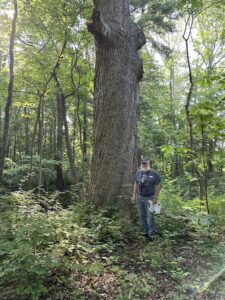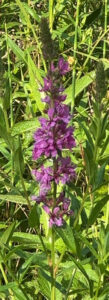Birding around Dayton, OH – who knew it could be this great! Part 1

One of the biggest birding hotspots in Ohio is Magee Marsh which is in the northern part of the state near Lake Erie. In fact, for 2 weeks every May, It is probably the hottest spot anywhere in the U.S. for migrating warblers. I have yet to go, but understand from friends who have been there that in addition to those weeks in May, the birding is great at this marsh all year round. There are many websites about Magee Marsh, but a good one to begin with is mageemarsh.org. And a free download is available – I love free downloads about anything bird!

But there are other, less well-known birding areas in Ohio that are also simply wonderful. For the next 2 days, Cleon and I will be exploring a few that are quite close to I-70. Lots of places to stay overnight – and some amazing restaurants. If you like good German food and craft beer, this part of Ohio is for you. And Cleon loves both! In fact, after this morning’s hikes and birding, Cleon settled into a wonderful craft beer and a plate of grilled sausages and potatoes. He may be Scots-Irish by genetics, but his favorite eating is all German!

Cleon and I are on a trip that will take us to Pennsylvania to meet up with friends, and from there, we are spending time in upstate New York – one of our favorite places. On the way to Pennsylvania, we decided to stop in Ohio and do some birding. I remembered an Audubon sanctuary – somewhere ……. not far from I-70 ……….. where my father and I spent a wonderful day back in the 1980’s. My father was not a birder, but he did like seeing them, and he fed them at his backyard feeders. He also liked walking trails through woodlands. So, remembering that wonderful day, I searched Cleon’s big atlas – an actual book! – and found it. Aullwood Audubon just outside Dayton. We decided to spend some time there. And then I found 3 other places in and around Dayton that looked good for birding. We went to 2 this morning and Cleon and I highly recommend both to you. (I will blog about the second one tomorrow – Woodman Fen.)

Aullwood Audubon (aullwood.audubon.org). We got there just as it opened – 9AM. The Visitor’s Center is large, spacious, full of interesting exhibits, and there is a lovely gift shop. There is a fee to get into the sanctuary. A friendly staff person – Marlene – helped us. She gave us a map of the grounds with the trails well-marked. She also traced out a good path for us – which included the wetland boardwalk in which I was very much interested – I truly love wetlands.
We walked and birded for about 40 minutes – probably about .75 of a mile. And in that time, we got a very nice list of different species. The area in which we were walking was wooded – gorgeous big trees – fully leafed out. We did not actually ‘see’ many of these species. But we sure heard them – singing and calling everywhere. We did have our Merlin app turned on, Cleon and I are pretty good at birding by ear – we can now reliably recognize dozens of songs. Merlin confirmed each one and gave us a few we did not recognize. (For more on the Merlin app, please go to this website’s menu and click Everything Bird!, go the topic “Help Identifying Birds”, then click on “Merlin App and Its Sound ID”.) Here is our list from Aullwood:
White-breasted Nuthatch American Robin Baltimore Oriole
Tufted Titmouse Carolina Wren Blue-gray Gnatcatcher*
White-eyed Vireo* Eastern Towhee Gray Catbird
Song Sparrow Northern Cardinal American Goldfinch
Brown-headed Cowbird Eastern Wood-Pewee Carolina Chickadee***
Northern Cardinal Yellow-throated Vireo ** Acadian Flycatcher*
Indigo Bunting Mourning Dove Blue Jay
Red-bellied Woodpecker
*We were not absolutely sure – Merlin confirmed.
**Unfamiliar song for us – Merlin IDed and we confirmed with a sighting.
***Neither Cleon nor I can identify whether a chickadee we observe is a Carolina or a Black-capped. For us, these birds look alike, sound alike, and these 2 birds have overlapping ranges in southern Ohio. (I discuss this at length in my ebook COMMON SONGBIRDS AND RAPTORS IN YOUR YARD, NEIGHBORHOOD, AND FAVORITE PARK.)

Aullwood Audubon is simply lovely. The trails are well maintained and fairly wide. The walking is easy. This is a wonderful place for birders, those who just want to get away for a time and be surrounded by nature, and for families. As we walked the trail, listening to singing and calling birds that were simply all through the woods, we could feel life’s tensions and worries just slip away and we were both the better for it. We were smiling!
The only down-side to Aullwood is the somewhat late opening time. For birders and nature photographers, 9AM is a late start. Especially as

summer months progress, birds will continue to sing at dawn, but they will sing less and less as the morning goes on. Right now at 9AM, the woods were full of singing birds. By mid-July? August? I am guessing the woods at 9AM will be much quieter. And woodland birds are often at the treetops – or within lots of leaves. They can be hard to impossible to locate with your eyes or with binoculars. And as the days get warmer, birds become quieter – sit motionless for longer and longer periods of time. In August, many begin to molt which is a quiet time for most birds. You can walk right by them and you will never see them. Birding in woodlands by ear helps to identify many birds, but even the Merlin app can’t help you when birds are quiet. I am sure there is a good reason as to why they open at 9AM instead of the more birder and photographer friendly 7AM (or even 6AM!), but I hope they reconsider. Other than that, both Cleon and I highly recommend this sanctuary. Lots and lots of birds; the trails are well-maintained; the visitor’s center is just lovely; and the woman who helped us, answered all our questions and she could not have been nicer or more helpful. Be sure to check out their website for events and all the other activities they offer besides simply excellent birding! And if you are at the Visitor’s Center, give Marlene a big hello!
I have posted a Video of a quiet moment in the middle of Aullwood. Enjoy!
One more thing – I took this photo at Aullwood, but they are far from alone in experiencing this invasive plant. The area in which I took this photo is small, and so eradication should not be as big a problem as it is for some refuge and sanctuary staff who are managing hundreds of acres of wetlands.
Purple Loosestrife (Lythrum salicaria). The bane of every manager of a refuge or sanctuary that contains a wetland. This plant was sold at garden centers in the 1980’s and 90’s – sadly, I sold my share of it. It is a beauritul perennial. Tough as nails. Gorgeous pink spikes that are long-lasting and make good cut flowers. Best of all it attracts butterflies. But in those years, no one understood how much of a self-seeder it was – is! – prolific is not a strong enough word. From a publication from the Minnesota Dept. of Natural Resources, it has been estimated that each mature plant can produce between 2 and 3 million seeds which are so light and tiny that the wind disperses them everywhere. And these seeds germinate and the plants thrive in wetlands. They create huge, almost impenetrable, pure stands of loosestrife which choke out all other plants and that includes our native species. Butterflies will use this plant for nectar, but according to the MN DNR, no other creatures use it and so these huge stands are almost useless to wildlife.
Dept. of Natural Resources, it has been estimated that each mature plant can produce between 2 and 3 million seeds which are so light and tiny that the wind disperses them everywhere. And these seeds germinate and the plants thrive in wetlands. They create huge, almost impenetrable, pure stands of loosestrife which choke out all other plants and that includes our native species. Butterflies will use this plant for nectar, but according to the MN DNR, no other creatures use it and so these huge stands are almost useless to wildlife.
As the plants mature, they form a complex rooting system of intertwining webs that become more difficult to remove with each passing year. Controlled burning generally does not kill the roots of this plant – an herbicide must be used. This is one of those difficult decisions – regardless of how careful people are, herbicides have the potential to harm much more than the target plants. Butterflies and moths – in particular – are greatly harmed by herbicides at all stages of their life. And it is always dangerous to use herbicides in wetlands or around any water. But allowing huge stands of these plants to form is also harmful to all things living in that area. A silver lining is that once the herbicide is applied and the loosestrife is gone, the area can be replanted and repopulated with the species that should be there, and then the environment nurtured so each species of plant and animal develops and establishes. Rich, one of the first wildlife refuge managers I worked for as a volunteer, used to always say to me when he and I had these sorts of discussions, “Linda, you can’t make an omelette without breaking a few eggs.” I hated it when he said that – my adage has always been “I want to have my cake and eat it, too.” But in the end, he was right. Sometimes harsh actions must be taken so nature’s order – which was always intended – can be restored.
Loosestrife was introduced into North America and is native to Europe and Asia. Had that not happened, wetlands would not be over-run by this plant today – to the detriment of everything else living there. Be careful with what you plant in your own garden! Initially what seemed to be an innocent, lovely plant that was easy to grow, turned into a nightmare.

